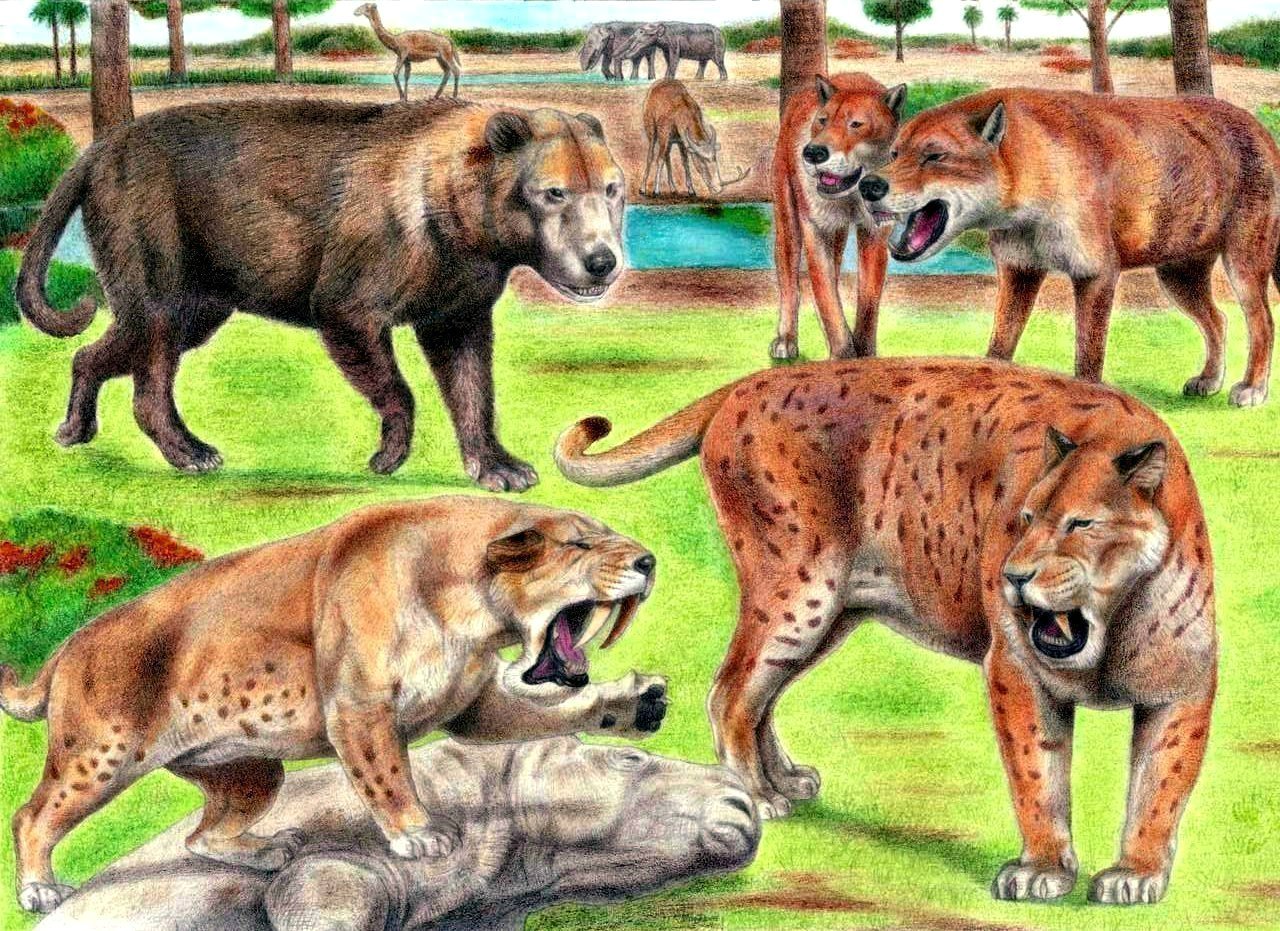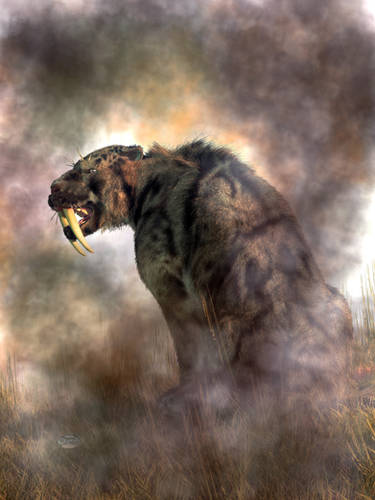ShopDreamUp AI ArtDreamUp
Deviation Actions
Description
'Miocene Florida / A carnivore Frenzy'
Please see the larger image.
Welcome back to the prehistoric safari service; this time you're witnessing the scene from south east of the North America about 8 million years ago.
The Miocene was simply the era of big bad carnivores: a numerous formidable meat eaters occupied large areas of the earth, competing day and night for their limited prey resources and for the top predator spot. This severe competitive environment was considered by some scientists as one of very factors that would lead to 'accentuation' of the so called 'sabertoothed cat morphology' : hypertrophied upper canines, wider mouth gaping ability and highly power oriented body designs that make rapid killing of large cumbersome preys possible by way of slashing bite method(sabertoothed predators itself already existed well before the Miocene in Nimravidae though!).
Genus Barbourofelis from the family Barbourofelidae seems to be the product of this tough era, sometimes regarded as the pinnacle of the morphological evolution toward power oriented big game hunting, even more so than the later machairodont phenom, Smilodon. The largest of this genus is said to have possessed longer saber canines, superior weaponry and grappling strength even than the largest Smilodon and should naturally be put as one of the most formidable among cat-like creatures and sabertooths.
From front to back:
>Hornless rhino (Teleoceras fossiger)
One of small to medium sized early rhinos which lacked horns.
>Middle sized Barbour's saber-toothed tiger (Barbourofelis loveorum)
>American proto scimitar cat (Nimravides / Machairodus catacopis)
This lion sized early machairodont was probably the same species as Eurasia's Machairodus aphanistus, marked by the primitive trait of a very long back, proportionally longer even than in most of felines not to mention later sabertooths.
>Middle sized American Bear dog (Amphicyon sp.)
The family Amphicyonidae is often called colloquially as 'bear dogs' because of their intriguing morphologies that are almost intermediate between Ursidae and Canidae plus very long back & tail(don't mistake them with 'hemicyon bears' whose nickname is 'half dogs' yet in fact are placed within the true bear family!).
Some species of this great family evolved into semi-plantigrate posture and became gigantic (A.giganteus in Europe for instance) while others acquired surprisingly canid-like shapes, bone crashing dentition and digitigrate posture.
>Giant Bonecracker dog (Epicyon haydeni)
By far the largest canid ever existed, probably weighing up to more than 300 lbs in extreme cases. As with most of other hyper-carnivorous borophagine dogs, their massive premolars were well adapted to bone crashing.
>Slingshot beast (Synthetoceras tricornatus)
This rather big, unique harbivore possessed literally 'Y' shaped long appendage on the tip of its upper jaw and thus the english nickname 'slingshot'.
>Humpless camel (Aepicamelus major)
A very tall yet slender early camel of the North America with no visible humps.
>Shovel tusked elephant (Amebelodon sp.)
There were several variations in so called 'shovel tasker' gomphotherids but in all cases, both upper and lower jaw bones protruded and lower tasks formed conspicuous shovel shape.
~Jagroar
Please see the larger image.
Welcome back to the prehistoric safari service; this time you're witnessing the scene from south east of the North America about 8 million years ago.
The Miocene was simply the era of big bad carnivores: a numerous formidable meat eaters occupied large areas of the earth, competing day and night for their limited prey resources and for the top predator spot. This severe competitive environment was considered by some scientists as one of very factors that would lead to 'accentuation' of the so called 'sabertoothed cat morphology' : hypertrophied upper canines, wider mouth gaping ability and highly power oriented body designs that make rapid killing of large cumbersome preys possible by way of slashing bite method(sabertoothed predators itself already existed well before the Miocene in Nimravidae though!).
Genus Barbourofelis from the family Barbourofelidae seems to be the product of this tough era, sometimes regarded as the pinnacle of the morphological evolution toward power oriented big game hunting, even more so than the later machairodont phenom, Smilodon. The largest of this genus is said to have possessed longer saber canines, superior weaponry and grappling strength even than the largest Smilodon and should naturally be put as one of the most formidable among cat-like creatures and sabertooths.
From front to back:
>Hornless rhino (Teleoceras fossiger)
One of small to medium sized early rhinos which lacked horns.
>Middle sized Barbour's saber-toothed tiger (Barbourofelis loveorum)
>American proto scimitar cat (Nimravides / Machairodus catacopis)
This lion sized early machairodont was probably the same species as Eurasia's Machairodus aphanistus, marked by the primitive trait of a very long back, proportionally longer even than in most of felines not to mention later sabertooths.
>Middle sized American Bear dog (Amphicyon sp.)
The family Amphicyonidae is often called colloquially as 'bear dogs' because of their intriguing morphologies that are almost intermediate between Ursidae and Canidae plus very long back & tail(don't mistake them with 'hemicyon bears' whose nickname is 'half dogs' yet in fact are placed within the true bear family!).
Some species of this great family evolved into semi-plantigrate posture and became gigantic (A.giganteus in Europe for instance) while others acquired surprisingly canid-like shapes, bone crashing dentition and digitigrate posture.
>Giant Bonecracker dog (Epicyon haydeni)
By far the largest canid ever existed, probably weighing up to more than 300 lbs in extreme cases. As with most of other hyper-carnivorous borophagine dogs, their massive premolars were well adapted to bone crashing.
>Slingshot beast (Synthetoceras tricornatus)
This rather big, unique harbivore possessed literally 'Y' shaped long appendage on the tip of its upper jaw and thus the english nickname 'slingshot'.
>Humpless camel (Aepicamelus major)
A very tall yet slender early camel of the North America with no visible humps.
>Shovel tusked elephant (Amebelodon sp.)
There were several variations in so called 'shovel tasker' gomphotherids but in all cases, both upper and lower jaw bones protruded and lower tasks formed conspicuous shovel shape.
~Jagroar
Image size
1280x931px 389.7 KB
Make
Canon
Model
CanoScan LiDE 600F
© 2012 - 2024 Jagroar
Comments38
Join the community to add your comment. Already a deviant? Log In
Quick question: was Barbourofelis present in the Balkans during the late Miocene (around 9 mya)? I'm trying to do a series of pieces and one of my subjects is Late Miocene Greece (one of the places Dinocrocuta was present) and want to make it as accurate as possible.



































